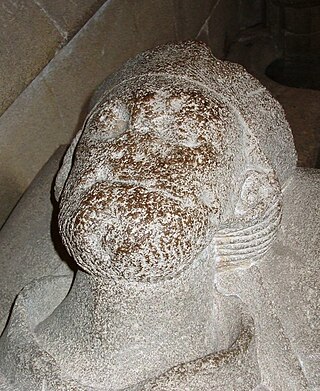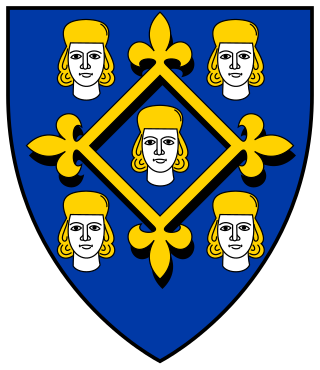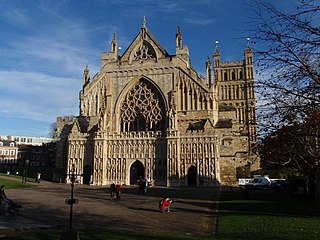Related Research Articles

Roger Northburgh was a cleric, administrator and politician who was Bishop of Coventry and Lichfield from 1321 until his death. His was a stormy career as he was inevitably involved in many of the conflicts of his time: military, dynastic and ecclesiastical.

Arthur Lake was Bishop of Bath and Wells and a translator of the King James Version of The Bible.

Gisa was Bishop of Wells from 1060 to 1088. A native of Lorraine, Gisa came to England as a chaplain to King Edward the Confessor. After his appointment to Wells, he travelled to Rome rather than be consecrated by Stigand, the Archbishop of Canterbury. As bishop, Gisa added buildings to his cathedral, introduced new saints to his diocese, and instituted the office of archdeacon in his diocese. After the Norman Conquest, Gisa took part in the consecration of Lanfranc, the new Archbishop of Canterbury, and attended Lanfranc's church councils. His tomb in Wells Cathedral was opened in the 20th century and a cross was discovered in his tomb.
John of Tours or John de Villula (died 1122) was a medieval Bishop of Wells in England who moved the diocese seat to Bath. He was a native of Tours and was King William I of England's doctor before becoming a bishop. After his consecration as bishop, he was either given or purchased Bath Abbey, a rich monastery, and then moved the headquarters of the diocese from Wells, to the abbey. He rebuilt the church at Bath, building a large cathedral that no longer survives. He gave a large library to his cathedral and received the right to hold a fair in Bath. Not noted for his scholarship, he died suddenly in 1122.

Archibald was a Scottish prelate best known for involvement in a dispute with the Pope.

Andrew Stewart was a 15th-century Scottish prelate and administrator.
Michael Ochiltree [Ouchtre] was a 15th-century Scottish prelate and administrator. A close associate of King James I of Scotland, from the late 1410s he rose in rank from canon to Dean of Dunblane and then Bishop of Dunblane. He was responsible for the coronation of King James II of Scotland, and he obtained a grant from the crown which allowed the comparatively small diocese of Dunblane to attain historically unprecedented viability.
William of Bitton was a medieval Bishop of Bath and Wells.

William of Louth, also known as William de Luda was a medieval Bishop of Ely.

The Dean of Exeter is the head of the Chapter of Cathedral Church of Saint Peter in Exeter, England. The chapter was established by William Briwere, Bishop of Exeter (1224–44) who set up the offices of dean and chancellor of Exeter Cathedral, allowing the chapter to elect those officers. The deanery is at 10 The Close, Exeter. The current dean is Jonathan Greener.
Thomas Wynter or Winter was the Archdeacon of York, Richmond, Cornwall, Provost of Beverley, Dean of Wells Cathedral and the illegitimate son of Cardinal Thomas Wolsey.

St Peter's Collegiate Church is located in central Wolverhampton, England. For many centuries it was a chapel royal and from 1480 a royal peculiar, independent of the Diocese of Lichfield and even the Province of Canterbury. The collegiate church was central to the development of the town of Wolverhampton, much of which belonged to its dean. Until the 18th century, it was the only church in Wolverhampton and the control of the college extended far into the surrounding area, with dependent chapels in several towns and villages of southern Staffordshire.
William Kingsmill alias William Basyng (?–1549) was Prior of St. Swithun's Priory, Winchester until the Dissolution of the Monastery in 1539; it was a Benedictine monastic house and its shrine to the saint popularly associated with determining the entire period of pre-harvest weather was a place of pilgrimage. He was appointed as the first Dean of Winchester Cathedral at the foundation of the new chapter in 1541.
George Chandler (1779?–1859) was an Anglican priest.

Henry Man was an English clergyman who served as the Bishop of Sodor and Man in the 16th century.
Thomas Tuttebury was the Dean of Wells at the beginning of the fifteenth century. He was also simultaneously Archdeacon of Buckingham.
William Cosyn was priest, a JP for Somerset from 1506–1516, and Dean of Wells Cathedral from 1498–1525.
John Goodman was Dean of Wells Cathedral from 1548 to 1550, and again from 1554 to 1561.
Benjamin Heydon or Haydon (1567–1607) was the Headmaster at Winchester College from 1596 to 1601/1602, a JP for Somerset, and Dean of Wells Cathedral from 1602 until his death in 1607.

Nicholas Marston was a 16th century English priest. It is uncertain whether his appointment as Archdeacon of Cornwall in 1574 took effect. He was one of three brothers, who had ecclesiastical careers in the Cathedral church of Exeter, and in that diocese within Cornwall and Devon. Their father was a wealthy citizen Haberdasher in the city of London who gave financial support to the early career of his wife's brother William Bradbridge, later bishop of Exeter. Thomas's daughters made advantageous City marriages, and the network of their mercantile patronage and relations with the bishops, deans and chapters of Exeter and of Bath and Wells, and with the University of Oxford, spanned several decades of the Tudor and early Stuart period.
References
- ↑ John Le Neve, et al. Fasti Ecclesiae Anglicanae, 1541-1857, 12 volumes (London, U.K.: 1969-2007), 5:5.
- ↑ Joseph Hunter, South Yorkshire: The History and Topography of the Deanery of Doncaster in the Diocese and County of York, 2 volumes (London, U.K.: 1828-1831) 1:242, 251, 2:54-57.
- ↑ P. A. Johnson, Duke Richard of York, 1411-1460 (Oxford, U.K.: 1988) p. 222, 231; Robert Somerville, History of the Duchy of Lancaster, Volume 1: 1265-1603, (London, U.K.: 1953) p. 529.
- ↑ Oxford Dictionary of Biography Online (ODNB Online), "William Fitzwilliam, Earl of Southampton" by William B. Robison.
- ↑ "Sir William Fitzwilliam (c. 1490-1542)" by S. R. Johnson in The History of Parliament: the House of Commons 1509-1558, 3 volumes, edited by S. T. Bindoff (London, U.K.: 1982) 2:142-145.
- ↑ Letters and Papers, Foreign and Domestic, of the Reign of Henry VIII (L&P), 26 volumes in 37 parts (London, U.K.: 1862-1932) 14.1, No. 522 (p. 295).
- ↑ Rosemary Horrox, "Servitude", in Fifteenth-Century Attitudes: Perceptions of Society in Late Medieval England edited by idem (London, 1994) pp. 61-72; Ann Kussmaul, Servants in Husbandry in Early Modern England (Cambridge, U.K.: 1981), pp. 3-8.
- ↑ Adam Fox, Oral and Literate Culture in England, 1500-1700, (Oxford, U.K.: 2000), p. 356.
- ↑ L&P, 13.1, Nos. 392, 440, 475.
- ↑ H. M. Colvin, ed. The History of the King's Works, 6 volumes (London, U.K.: 1963-1982), 4:527-530.
- ↑ L&P, 14.2, Nos. 309, 710, 782 (p. 327).
- ↑ Diarmaid MacCulloch, Thomas Cromwell: A Revolutionary Life, (New York, NY: 2018) pp. 420, 506-527.
- ↑ D. S. Chambers, ed. Faculty Office Registers, 1534-1549: A Calendar of the First Two Registers of the Archbishop of Canterbury's Faculty Office, (Oxford, U.K.: 1966) p. 226; C. W. Boase, ed. Register of the University of Oxford, Volume 1: 1449-1463, 1505-1571, (Oxford, U.K.: 1885) p. 207.
- ↑ Historical Manuscripts Commission, Calendar of the Manuscripts of the Dean and Chapter of Wells (Cal. Mss. Wells), 2 volumes (London, U.K.: 1907-1914) 2:252-253.
- ↑ Stanford Lehmberg, The Reformation Parliament, 1529-1536 (London, U.K.: 1970) p. 192; Statutes of the Realm, 11 volumes (London, U.K.: 1810-1828) 3:464-471.
- ↑ Henry Maxwell-Lyte, ed. The Registers of Thomas Wolsey, John Clerk, William Knyght, and Gilbert Bourne, Bishops of Bath and Wells, (London, U.K.: 1940) pp. 95-96.
- ↑ Cal. Mss. Wells, 2:260; List and Index Society, Exchequer, Augmentation Office, Calendar of Ancient Deeds, Series B, 4 volumes, (London, U.K.: 1973-1976) Vol. 2, No. 7573.
- ↑ Anthony Wood, Athenae Oxonienses: An Exact History of All the Writers and Bishops...of Oxford...1500-1690, 2 volumes (London, U.K.: 1691-1692) 1:698; Anthony A. Wood and Philip Bliss, eds. Fasti Oxonienses; or Annals of the University of Oxford, 1500-1691, 2 volumes (London, U.K.: 1815-1820) 1:120.
- ↑ James McConica, ed. The History of the University of Oxford, Volume 3: The Collegiate University, (Oxford, U.K.: 1986) p. 553; Andrew Clark, ed. Register of the University of Oxford, Volume 2: 1571-1622, 4 parts (Oxford, U.K.: 1887-1889) 1:63-64.
- ↑ ODNB Online, "Edward Seymour, First Duke of Somerset" by Barrett L. Beer; Victoria County History of Somerset, Volume 2, edited by William Page (London, U.K.: 1911) p. 48; Phyllis M. Hembry, The Bishops of Bath and Wells, 1540-1640: Social and Economic Problems, (London, U.K.: 1967), pp. 105-123.
- ↑ Cal. Mss. Wells, 2:264.
- ↑ W. C. Richardson, ed. The Report of the Royal Commission of 1552, (Morgantown, WV: 1974) pp. 89-91; J. D. Alsop, "The Revenue Commission of 1552", 'The Historical Journal', Vol. 22, No. 3 (September 1979) pp. 511-533.
- ↑ Derrick S. Bailey, The Canonical Houses of Wells, (Gloucester, U.K.: 1982) p. 104; idem, ed. Wells Cathedral Chapter Act Book, 1666-1683, (London, U.K.: 1973), p. v.
- ↑ Hug, Impostures in Early Modern England: Representations and Perceptions of Fraudulent Identities, (Manchester, U.K.: 2009) p. 25.
- ↑ Calendar of the Patent Rolls Preserved in the Public Record Office: Edward VI, 6 volumes (London, U.K.: 1921-1929), 1:192.
- ↑ Athenae Oxonienses 1:698.
- ↑ Le Neve, Fasti Ecclesiae Anglicanae; or, An Essay Towards Deducing a Regular Succession...in each Cathedral, Collegiate Church or Chapel... (London, U.K.: 1716) p. 36; A Catalogue of the Lansdowne Manuscripts in the British Museum, 2 volumes (London, U.K.: 1819) p. 243; Hutchins, ed. History and Antiquities of the County of Dorset, 3rd edition, 4 volumes (London, U.K.: 1861-1870) 4:129; Foster, ed. Alumni Oxonienses: The Members of the University of Oxford, 1500-1714, 4 volumes (London, U.K.: 1891) 2:504.
- ↑ L&P, 13.1, Nos. 392, 475; Chambers, Faculty Office Registers, p. 226; Cal. Mss. Wells 2:253-266; Maxwell-Lyte, ed. Registers of Bath and Wells, pp. 95-96; Boase, ed. Register of the University of Oxford, p. 207; Richardson, ed. Royal Commission of 1552, p. 91.
- ↑ Godwin, De Praesulibus Angliae Commentarius, (London, U.K.: 1616) p. 449; Wharton, Anglia Sacra, Sive Collectio Historiarum..., (London, U.K.: 1691) 1:590.
- ↑ Victoria County History of Somerset, Volume 2, p. 48; Hembry, The Bishops of Bath and Wells, p. 117; Bailey, Wells Cathedral Chapter Act Book, p. v; Colchester, ed. Wells Cathedral: A History, (Wells, U.K.: 1982), p. 46; Le Neve, et al. Fasti Ecclesiae Anglicanae, 5:5.